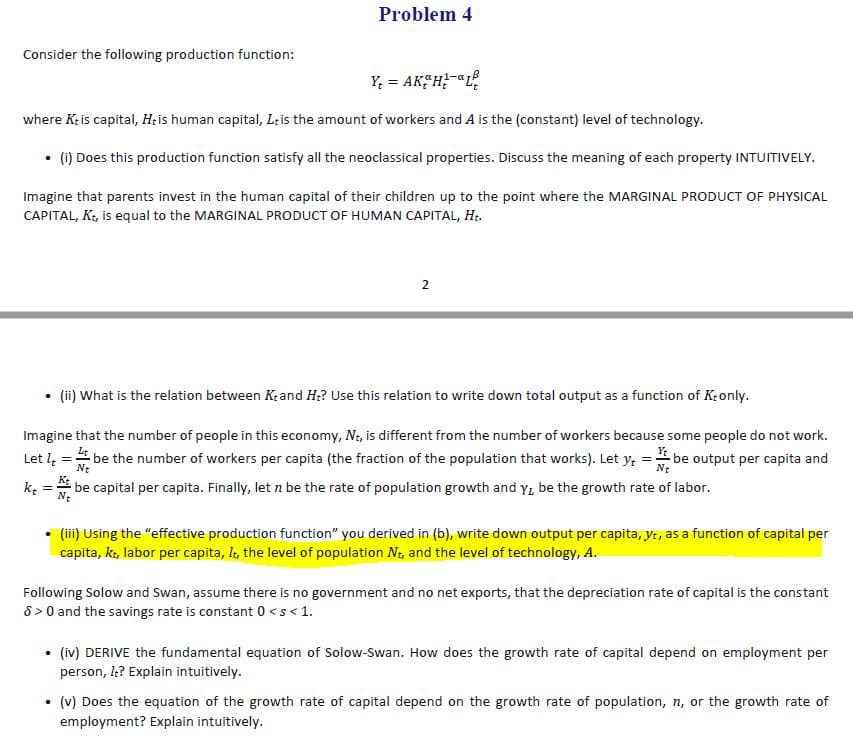Consider the following production function: Y; = AKSH!-"L %3! where K; is capital, H;is human capital, Leis the amount of workers and A is the (constant) level of technology. • (1) Does this production function satisfy all the neoclassical properties. Discuss the meaning of each property INTUITIVELY. Imagine that parents invest in the human capital of their children up to the point where the MARGINAL PRODUCT OF PHYSICAL CAPITAL, Kr, is equal to the MARGINAL PRODUCT OF HUMAN CAPITAL, H:. • (ii) What is the relation between Krand H:? Use this relation to write down total output as a function of Kronly. Imagine that the number of people in this economy, N, is different from the number of workers because some people do not work. Let =be the number of workers per capita (the fraction of the population that works). Let y, be output per capita and k = be capital per capita. Finally, let n be the rate of population growth and Y be the growth rate of labor. Ne
Consider the following production function: Y; = AKSH!-"L %3! where K; is capital, H;is human capital, Leis the amount of workers and A is the (constant) level of technology. • (1) Does this production function satisfy all the neoclassical properties. Discuss the meaning of each property INTUITIVELY. Imagine that parents invest in the human capital of their children up to the point where the MARGINAL PRODUCT OF PHYSICAL CAPITAL, Kr, is equal to the MARGINAL PRODUCT OF HUMAN CAPITAL, H:. • (ii) What is the relation between Krand H:? Use this relation to write down total output as a function of Kronly. Imagine that the number of people in this economy, N, is different from the number of workers because some people do not work. Let =be the number of workers per capita (the fraction of the population that works). Let y, be output per capita and k = be capital per capita. Finally, let n be the rate of population growth and Y be the growth rate of labor. Ne
Chapter1: Making Economics Decisions
Section: Chapter Questions
Problem 1QTC
Related questions
Question

Transcribed Image Text:Problem 4
Consider the following production function:
Y, = AKÇH!-"L
where Kr is capital, H;is human capital, Leis the amount of workers and A is the (constant) level of technology.
• (1) Does this production function satisfy all the neoclassical properties. Discuss the meaning of each property INTUITIVELY.
Imagine that parents invest in the human capital of their children up to the point where the MARGINAL PRODUCT OF PHYSICAL
CAPITAL, K, is equal to the MARGINAL PRODUCT OF HUMAN CAPITAL, H:.
2
• (ii) What is the relation between K:and H:? Use this relation to write down total output as a function of Kronly.
Imagine that the number of people in this economy, Nr, is different from the number of workers because some people do not work.
Let l
=4 be the number of workers per capita (the fraction of the population that works). Let y;
ミ
be output per capita and
be capital per capita. Finally, let n be the rate of population growth and y, be the growth rate of labor.
(ii) Using the "effective production function" you derived in (b), write down output per capita, yt, as a function of capital per
capita, k, labor per capita, I, the level of population Nr, and the level of technology, A.
Following Solow and Swan, assume there is no government and no net exports, that the depreciation rate of capital is the constant
8 > 0 and the savings rate is constant 0 <s< 1.
(iv) DERIVE the fundamental equation of Solow-Swan. How does the growth rate of capital depend on employment per
person, l:? Explain intuitively.
(v) Does the equation of the growth rate of capital depend on the growth rate of population, n, or the growth rate of
employment? Explain intuitively.
Expert Solution
This question has been solved!
Explore an expertly crafted, step-by-step solution for a thorough understanding of key concepts.
This is a popular solution!
Trending now
This is a popular solution!
Step by step
Solved in 2 steps

Recommended textbooks for you


Principles of Economics (12th Edition)
Economics
ISBN:
9780134078779
Author:
Karl E. Case, Ray C. Fair, Sharon E. Oster
Publisher:
PEARSON

Engineering Economy (17th Edition)
Economics
ISBN:
9780134870069
Author:
William G. Sullivan, Elin M. Wicks, C. Patrick Koelling
Publisher:
PEARSON


Principles of Economics (12th Edition)
Economics
ISBN:
9780134078779
Author:
Karl E. Case, Ray C. Fair, Sharon E. Oster
Publisher:
PEARSON

Engineering Economy (17th Edition)
Economics
ISBN:
9780134870069
Author:
William G. Sullivan, Elin M. Wicks, C. Patrick Koelling
Publisher:
PEARSON

Principles of Economics (MindTap Course List)
Economics
ISBN:
9781305585126
Author:
N. Gregory Mankiw
Publisher:
Cengage Learning

Managerial Economics: A Problem Solving Approach
Economics
ISBN:
9781337106665
Author:
Luke M. Froeb, Brian T. McCann, Michael R. Ward, Mike Shor
Publisher:
Cengage Learning

Managerial Economics & Business Strategy (Mcgraw-…
Economics
ISBN:
9781259290619
Author:
Michael Baye, Jeff Prince
Publisher:
McGraw-Hill Education